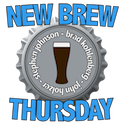Looking Through Beer Colored Glasses
When rating and tasting beer, it is absolutely crucial to evaluate its appearance. This is why I will always pour a bottled beer into a glass. Color affects the way people percieve a beer and gives it expectations. The color of beer can be a powerful but often subconscious generator of positive or negative responses developed pre-tasting.
For American brewers, the Standard Reference Manual (SRM) is the standard measure for degrees of color as related to beer and the grains used to brew it. SRM is roughly the equivalent of Degrees Lovibond (degL), the British measurement of color. The numbers are about the same between the two scales, and they tend to be used interchangably — unless beer color moves into the amber regime, at which time the relationships between visual and spectrophotometric units start to diverge sharply.
Lovibond Units are ranked by color and hue, ranging from 2 for light yellow to 25 for black. Here is a simple scale:
The color degL, which depends on the color of the malt, ranges from 1 to around 600. Lower values of the color measurement correspond to lighter beers and higher values to darker beers. For example: pilsner malt measures 1 while black patent malt, a grain commonly used in stout, rates around 550.
Europe and most of the world use a different scale called the EBC (European Brewing Congress). To find the EBC equivalent on an SRM scale, take the SRM and multiply by 2.65, then subtract 1.2. (This is approximated, but very close.)
Commercial breweries measure SRM color using a spectrophotometer, a sophisticated device that provides an accurate machine measurement of the quantity of monochromatic light, either absorbed, or passing through, the liquid.
Malt color is not the only factor that determines beer color. According to the source, BeerRecipes.com:
Differences in brewing conditions can lead to substantial color changes in the finished beer, these effects being particularly important for beers at 5 degL or less.
Water. As the alkalinity of the water increases, so does the extraction rate of the coloring pigments in malt. The mash pH I has the same effect, and increasing pH leads to worts with deeper color.
Mash. Color increases with the amount of contact time with the grains. Thus, a prolonged mash will produce a deeper-colored beer than a short mash.
Kettle boil. The Maillard reaction also takes place as wort is boiled; therefore, wort color increases with boil time. A fact that is sometimes overlooked is that wort simmering has the same effect. The point is that this will lead to an incomplete hot and cold break, which in turn leaves more coloring elements in the finished wort.
Hops. Some color is obtained from hops both in the kettle and in storage containers when postfermentation hopping is used.
Fermentation. The proteinous matter produced during the cold break is full of coloring materials and, hence, removal of these materials will reduce color. It has been reported that color changes during fermentation vary with yeast strain.
Filtration. This can dramatically reduce color. It should be noted that a clear beer will appear to be lighter color than turbid beer.
Oxidation. At all stages of brewing, air pickup will deepen beer color. This is as true of hot wort production as it is of bottled beer with head-space air.
For additional information on beer color check out: Beer Color Laboratories.

















thomas February 26th, 2008 at 1:51 am
There once was a man named Bertold
Who drank beer when the weather grew cold
As he reached for his cup…
“NEEEEVER GONNA GIVE YOU UP!!!”
Oh, snap! You just got limerickrolled!
… great post as always. This all would make a great color scheme for a beer drinking room.